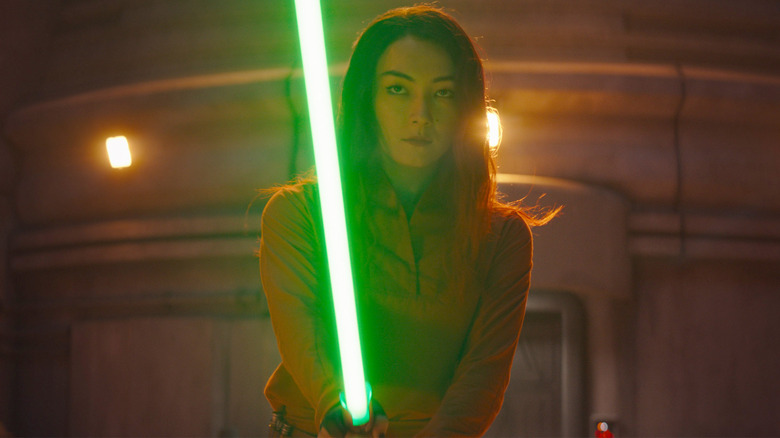Did The Ahsoka Finale Really Change How The Force Works In Star Wars?
In "Ahsoka" Episode 8, Sabine Wren (Natasha Liu Bordizzo) uses the Force to both grab a distant lightsaber and help propel Ezra Bridger (Eman Esfandi) through the air. Throughout "Ahsoka," Sabine clearly possesses no natural aptitude for the Force, so her use of these abilities effectively canonizes the notion that the capacity to tap into the Force isn't limited to so-called Force-sensitive individuals but is latent in everyone or perhaps even every living thing.
Some "Star Wars" fans might consider this a retcon given that there's reason to believe Force sensitivity is inherited genetically rather than simply learned. Notoriously, in "Star Wars: Episode I — The Phantom Menace," Obi-Wan Kenobi (Ewan McGregor) argues that Anakin Skywalker's (Jake Lloyd) unparalleled midi-chlorian count means he'll make a uniquely powerful Jedi. A lack of midi-chlorians, then, would implicitly nullify someone's ability to use the Force. Even back in the original "Star Wars" trilogy, Luke Skywalker (Mark Hamill) turning out to be Darth Vader's son (James Earl Jones) suggests that Force sensitivity is something that's passed down. This idea is reinforced in "Star Wars: The Clone Wars" Season 2, Episode 3, which details how the Jedi Council seeks out particularly Force-sensitive children to train.
None of this information, however, invalidates the connection those who aren't naturally Force sensitive might still be capable of building with the Force. So, rather than changing how the Force works, "Ahsoka" simply clarifies that, while different people may exhibit different aptitudes for it, virtually anyone can wield the Force.
George Lucas always considered the Force to be universal
When Obi-Wan (Alec Guinness) introduces Luke to the Force in the very first "Star Wars" film, he describes it as a sort of universal constant. "It's an energy field created by all living things," he says.
None other than "Star Wars" creator George Lucas expounded upon this conception of the Force during the making of the original trilogy. Author J.W. Rinzler, who authored a series of "The Making of Star Wars" books, recounted one conversation of note in a blog post to the official "Star Wars" website. In response to "Star Wars: Episode V — The Empire Strikes Back" screenwriter Lawrence Kasdan asking him who could use the Force, Lucas stated in no uncertain terms that anyone can. " If you want to take the time to do it, you can do it; but the ones that really want to do it are the ones who are into that kind of thing," he explained.
Rinzler even recounted Lucas describing midi-chlorians residing within every living thing. So, while midi-chlorians are often invoked to suggest the Force is genetic and reliant on midi-chlorian count, it turns out that their creator has granted every living thing within his fictional universe access to them. Sabine Wren isn't an exception, then, but merely a rare example of someone without a natural connection to the Force who nevertheless learned to bend it to her will.

